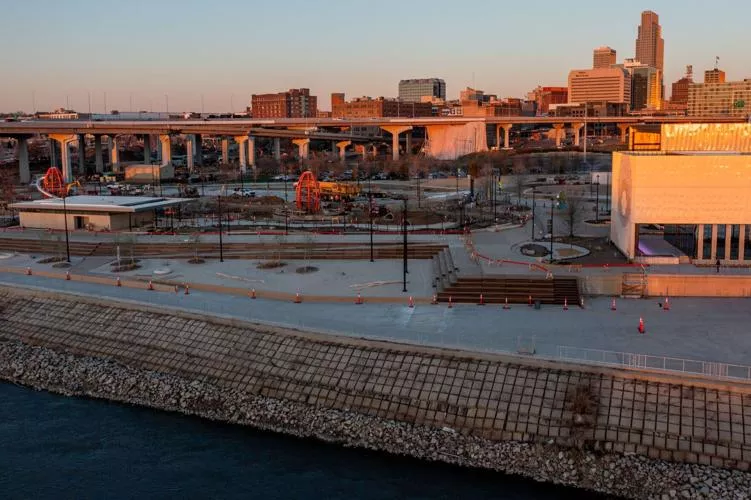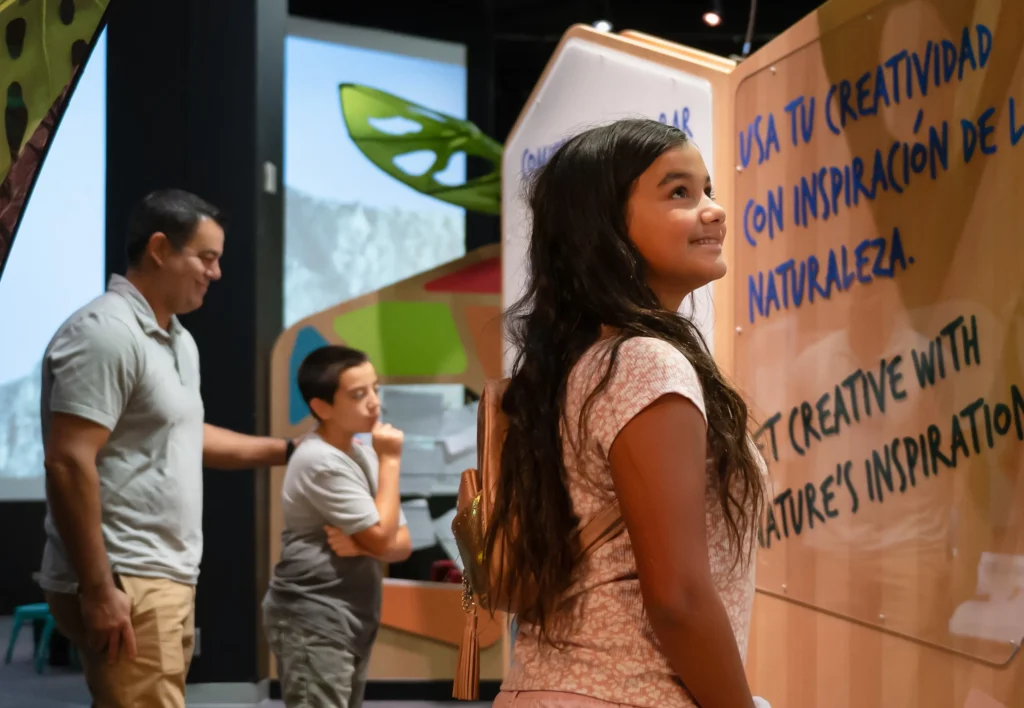Mayor Gene Leahy embraced the vision of connecting downtown to the river. In 1973, he tapped Yanney, a young bank executive, to head a 600-person revitalization committee that sought to make the central plaza to the river a reality.
Nearly six square blocks of historic buildings between Eighth and 14th Streets fell to make way for what became Gene Leahy Mall, a sunken park with walkways surrounding an artificial waterway.
The first block of the park opened in 1977, but it was not extended all the way to Eighth Street until the early 1990s. The park’s waterfalls and other features initially proved an attraction and helped spark millions of dollars of new investment around the park’s edges.
Then in the late 1980s, ConAgra was looking to build a new headquarters campus downtown. Shukert says city leaders saw it as an opportunity to finally extend Leahy Mall to the river and make Marina City a reality.
But creating the marina would have involved breaching the river levee and putting in floodgates instead, and that would have required a years-long process to get a federal OK from the U.S. Army Corps of Engineers. Unfortunately, Shukert said, that did not fit with the timetable of Mike Harper, ConAgra’s famously hard-charging CEO.
The result instead in 1990 was Heartland of America Park, where the envisioned marina was replaced by a lake with a fountain in the middle that spouted geysers high into the air.
Making way for the ConAgra campus required knocking down the Jobbers Canyon warehouse district, the largest-ever demolition of a designated U.S. historic district. And while the new 30-acre park connected the Leahy Mall with the river, the park fell far short of its promise.
Initially, it was impossible to walk completely around the lake because ConAgra gated its side. And the riverfront park’s odd layout meant that the only place one could get a good look at the actual river was to walk out on an overlook platform at the most remote end of the park.
The park provided some postcard views of downtown and hosted some local events like the Taste of Omaha food festival, but it otherwise drew few people to the river.
Omaha soon had a chance to develop another major riverfront park.
Hal Daub was elected mayor in 1995 with visions of constructing a new arena and convention center on the riverfront. For the site, he targeted the vast Union Pacific shops facility, which the railroad had shut down in 1988.
But to make the project a reality, he also took aim at the other remaining vestiges of industry along the river, including the Asarco lead smelting plant that had been spewing lead pollution over the city for 125 years.
Daub one day called the registered agent for Asarco in New York and left a message: “It’s my intention to file a lawsuit in federal court against Asarco for violation of the Clean Air Act and Clean Water Act.”
The agent called back. Daub’s legal threat prompted talks that ended with Asarco pledging to close the plant by 1997 and provide $50 million to clean up the toxic site.
Looking back now, Shukert said getting Asarco off the Missouri paved the way for everything that has happened on the riverfront since.
“It was crucial,” Shukert said.
The Union Pacific rail yards in 2003 became the home of Omaha’s new arena. And Asarco and other neighboring industrial sites made way for Gallup’s riverfront campus, the U.S. Park Service’s regional headquarters and the city park named Lewis & Clark Landing.
Opening in 2003, the park included a marina, a restaurant and lots and lots of concrete. No trees were planted for fear their roots would penetrate the underground cap that helped contain the lead-contaminated soil below. Both the lead concerns and flood walls posed challenges as the new park was imagined.
The new park offered scenic river vistas. But the uninviting concrete space also fell short of its promise. The restaurant eventually closed.
One bright spot on the river came soon after, just to the north of the Parks Service building, when Nebraska U.S. Sen. Bob Kerrey secured a $19 million congressional earmark for a pedestrian bridge across the river to Iowa. Dedicated in 2008, the majestic, sweeping span eventually named for Kerrey has been a magnet for families and visitors alike.
Most importantly, it also showed that if you build the right stuff on the river, people will come.
* * * *
If Gene Leahy Mall, Heartland of America and Lewis & Clark Landing were originally built without much to do, civic leaders are now going overboard in making sure those who visit in the future won’t be bored. In fact, if you can’t find something to do in the new parks, you probably should stay home.
It all began a half-dozen years ago when a group of Omaha philanthropists became interested in reimagining the riverfront parks and the Leahy Mall, which by then was showing its age.
They formed the nonprofit Downtown Riverfront Trust. Headed by Ken Stinson, chairman emeritus of the Kiewit construction company, and Mogens Bay of Valmont Industries, the new group raised nearly all the money for the parks overhaul.
Leaders of the group spent months traveling around the country visiting other parks and civic spaces, collecting ideas they wanted to replicate in Omaha and putting their own spin on them.
“There was a lot more thinking put into how people can use parks and what’s going to attract people,” said Bruce Grewcock, chairman of Kiewit’s board. “That drove a lot of Ken and Mogens’ thinking.”
When the group considered what they could put on the river that would draw people year-round, they soon latched on to the idea of a science museum — an amenity long missing on the Omaha cultural landscape.
Besides adding more pizazz, goals of the ambitious 90-acre parks makeover included better connecting the downtown parks and increasing accessibility.
The Leahy renovation was launched in 2019 and was completed July 1 last year. The sunken park has been transformed into a wide public plaza with an amphitheater, dozens of tables and benches for lounging around, public sculptures, and activities that range from climbers, swings, a water playground, a dog park and pingpong tables.
Shukert said as important as the physical amenities at the park is the free weekly programming offered, like Easter egg hunts, yoga classes, group walks, dog training sessions and live music.
He lauded the idea of having the Metropolitan Entertainment and Convention Authority operate the new downtown parks. After all, he said, MECA, the quasi-governmental organization that runs the CHI Health Center Omaha and Charles Schwab Field, is in the entertainment business.
In less than a year, MECA’s programming team has helped to facilitate over 500 events on the mall, including a free grand opening concert in the amphitheater by Broadway star Kristin Chenoweth.
“The activities are as important as the space itself,” Shukert said.
There’s much more to come. Last week, preparations were continuing for the next phase in the transformation of downtown and the riverfront.
The final landscaping was going in at the Luminarium, located on the site of the failed restaurant at Lewis & Clark Landing.
“People will have a purpose to come down to Lewis & Clark Landing now,” said Katie Bassett, MECA’s vice president for parks, as she stood outside the Luminarium last week. “It’s a destination now.”
And she wasn’t just talking about the Luminarium. Behind her, dozens of construction workers were putting finishing touches on both riverfront parks, which are set to reopen this summer.
At Lewis & Clark Landing, Bassett showed off the sands of an urban beach and a playground with climbers and ziplines that’s four times the size of the one at Leahy. Sand volleyball courts are in the works, too.
The other thing you’ll see at Lewis & Clark Landing: Lots of trees. Nearly 500.
Working with environmental regulators, MECA came up with varieties of oak, maple, sycamore, linden and other trees with compact root balls that won’t threaten the lead cap. The trees also have irrigation systems to make sure their thirsty roots won’t probe deep in search of water.
“This was previously kind of a concrete jungle,” Bassett said.
At Heartland of America, a ribbon-like skating track — for roller skating much of the year, and refrigerated for ice skating in winter — is taking shape. Also in the works are courts for bocce and pickleball, a racquet sport skyrocketing in popularity.
The landscape of the park has also been reconfigured so you no longer have to venture out on a walkway to catch a glimpse of the river. The Missouri is visible all along a path atop the levee that runs along the park’s east end.
“It’s important to actually see the river,” Bassett said.
The renovations have preserved a few things at each of the parks: The slides at Gene Leahy. The marina at Lewis & Clark Landing.
The lake and fountain at Heartland of America. Except when the fountain spouts up its geysers in the future, there’s a far better chance people will actually be there to see it.
Daub, Shukert and Yanney said last week they take pride in where the ground-breaking efforts 50 years ago to get back to the river have now led the city.
“To have a state-of-the-art facility like the Luminarium opening is a huge thing for Omaha,” Shukert said. “The fact it will be on the riverfront will give people a reason to go downtown and relate to the river. It’s very exciting to see.”
Yanney said he can already see the success of the revamped Leahy Mall. The 90-year-old’s home and office on the 28th floor of the WoodmenLife Tower looks straight down the mall, giving him a bird’s-eye view of all the people and activity in the park that he first helped develop.
Daub and his wife already had their time-stamped tickets to visit the Luminarium just after noon on Saturday.
“If you look at the past 30 years, here’s another giant step forward and a crown jewel of the efforts,” he said. “I think the riverfront will continue to flourish. It’s so powerful, so positive and so exciting.”



